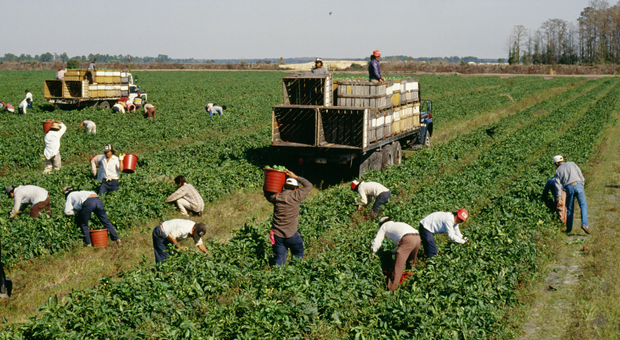28
Feb
EPA Proposes Reinstating Obama-era Farmworker Protections and Adds Compromises with Industry

(Beyond Pesticides, February 28, 2023) The Environmental Protection Agency (EPA) filed a proposed rule this month to update the way farmers, farmworkers, and bystanders are protected from toxic pesticide applications. The rule, which governs “Application Exclusion Zones” (AEZs), is being put forth to reinstate an Obama-era rule with the addition of some new industry-friendly provisions. EPA characterizes a return to the past with the adoption of former protections, after a period of deep deregulation under the Trump Administration, as a step forward in protecting farmworkers from toxic exposure. “EPA’s top priority is to protect public health and the environment, and today’s proposal is a significant step forward to further protect the farmworkers, farmers and pesticide handlers who deliver the fuel, fiber and food that runs America,” said EPA Administrator Michael S. Regan. “Farmworker justice is environmental justice, and we’re continuing to take action to make sure these communities are protected equally under the law from pesticide exposure.” However, within the historical context of this proposal, it appears as though the agency will end up with rules that are weaker, and more industry-friendly than those currently in place before the Trump Administration.
AEZs are buffer zones where individuals are not allowed to enter during the course of a pesticide application. The rules governing these areas are part of EPA’s Worker Protection Standards (WPS) for farmworkers, laws that govern labor safety standards within federal pesticide law (the Federal Insecticide Fungicide and Rodenticide Act, or FIFRA). Farmworkers are not covered for toxic chemical exposure by the U.S. Department of Labor’s Occupational Safety and Health Administration (OSHA), and WPS have long been criticized by farmworker, labor, and health advocates for providing insufficient protections for farmworker communities.
In 2015, the Obama administration made the first revisions to the larger (WPS) for farmworkers in 25 years, including some expansion no-entry buffer zones. Those changes aimed to improve farmworker and farm family protections, including from significant off-site drift of aerially sprayed pesticides. After these rules were finalized, the pesticide industry launched an aggressive lobbying campaign to reverse the protections. Finding traction in the Trump administration, then-EPA Administrator Scott Pruitt announced plans in 2017 to revisit the rules, reconsidering AEZ buffer zone sizes, provisions that prohibit children under 18 from spraying toxic pesticides, and the ability for farmworkers to have a ‘designated representative’ obtain information about the pesticides being applied around them. Most of these changes were mitigated by negotiations with U.S. Senators in 2019, but alterations to AEZs remained on the table.
The Trump administration released provisions that i) shrunk the size of AEZ buffer zones from 100 ft around a pesticide application to 25ft; ii) apply AEZs only to a farm owners property, not all sites where pesticides are applied; iii) exempt family members living on farms from requirement to leave the area during a pesticide application; and iv) allow a suspended pesticide application to continue when an individual leaves an AEZ. Alongside industry associations like the American Farm Bureau, EPA focused on how these weaker standards provided “greater flexibility for farmers.”
While the Trump EPA rule was finalized in 2020, a lawsuit brought by the groups Farmworker Justice and Earthjustice was filed shortly after, and ultimately successful in blocking the rule’s implementation. This restraining order issued by the U.S. District Court for the Southern District of New York set the stage for the incoming Biden administration to determine whether to defend the industry friendly proposal or allow it to fall by the wayside.
It appears the Biden EPA has tried to split the issues of concern–retaining some of the protective measures, while reproposing certain industry friendly provisions. Advocates say it is disingenuous for the agency to bill this proposal as “reinstating” and strengthening protections,” when the status quo of no action would maintain the stronger protections from the 2015 Obama WPS.
Specifically, the Biden EPA plans to “reinstate” (in other words, keep) protections maintaining 100 ft buffer zones, and provisions applying AEZs to all sites where a pesticide is sprayed. Yet, it is reproposing measures that allow a suspended pesticide application to resume after people leave an AEZ, and exempt family members living on farms from a requirement to leave the area during a pesticide application.
Shifting the status quo and compromising with more industry-friendly approaches, while characterizing them as “modernizing” protections, cannot be viewed as the Biden Administration moving strong environmental justice policy. Allowing the start and stop of a pesticide application raises serious issues of enforceability and increases the risk of misuse and improper applications and allowing family members to stay on site while toxic chemicals are sprayed places them at significant risk; it amounts to a dereliction of the agency’s duty to inform farmers and the public about the inherent hazards of pesticide use, and the real hazards associated with pesticide exposure.
It is clear that farmworkers need more protections, not industry-friendly compromises. Currently, the average life expectancy for a farmworker is 49 years, compared to 78 for the general population. This is similar to the life expectancy of individuals living in the 1850s and represents a completely unacceptable data point for any industry today.
Take action today to tell Congress to reform pesticide law in a way that meaningfully protects farmworkers, and get further involved to make sure governments take environmental justice seriously.
All unattributed positions and opinions in this piece are those of Beyond Pesticides.
Source: EPA press release










